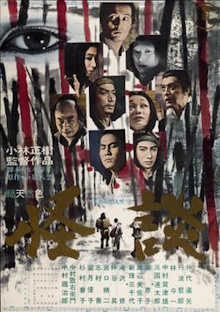This anthology horror film by Masaki Kobayashi consists of four separate stories and clocks in at three hours. The stories are all adapted from Japanese folklore, which explains why some are likely variations of stories everyone has already heard of. It’s rough going at first as it looks very much like something shot on a stage and the plot is just too predictable. But then I noticed that stories steadily improve in sophistication and even production values and started to appreciate the film better. I won’t say the film looks that good as you have to make a deliberate effort to buy into the stagecraft but it does some make bold artistic choices. The selection is overall quite good, representing a broad spectrum of traditional Japanese ghost stories.
“The Black Hair” is about an impoverished samurai who leaves his wife behind in Kyoto in order to seek a better paid position elsewhere. He later marries another wife from a wealthy family but finds her selfish and callous. He regrets his choice and returns to Kyoto to find his house in ruins but his old wife still there and you can guess the rest from there. “The Woman in the Snow” is about a young man and an older woodcutter who are driven to take shelter in a hut during a blizzard. He witnesses a yuki-onna sucking the life force out of the older man but the ghost spares him, telling him never to recount the incident to anyone. Later he just happens to meet a young woman travelling by herself and marries her with a predictable outcome. “Hoichi the Earless” is a blind monk who happens to be skilled with the biwa, especially at performing The Tale of the Heike about the Battle of Dan-no-ura. One night a ghostly samurai appears and tells him that his lord has heard of his prowess and wishes a performance, but Hoichi being blind is unaware that he is a ghost. “In a Cup of Tea” starts with a frame story with a writer remarking that some stories passed down from the past are unfinished. He cites as an example of a samurai who sees in his cup of tea the face of a strange man.
The first two stories risk being so familiar that they’re boring. The most notable element of the first story is the use of the long, lustrous black hair of the wife as a motif, first as a point of attraction and later as something horrifying the samurai is unable to escape from. I was confused however by how the newer wife has similar long, black hair. I didn’t much care for the second story at all. The way it has the actor trudge all across a stage pretending that it’s a snow-filled forest is just too fake for me. The third story starts with a stylized depiction of the Battle of Dan-no-ura with the samurai fighting from ships. All of it takes place on a stage as well but the scale and mise-en-scène is quite impressive and I liked how it actually has a more interesting plot. The final story has a meta aspect which instantly makes it feel much more modern. It’s also more of a strange and inexplicable encounter than a mere ghost story and that actually makes it more horrifying to me.
As with the other films of its era, it relies on lighting, makeup, costumes and editing to convey a sense of the supernatural. I’d say success is mixed at best so you’d have to willfully accept what they are doing, as if watching it live on stage. There are some cultural aspects that are intriguing such as the first samurai’s wife promising to earn money as a weaver so that he won’t leave and the fact that these ghost and spirits don’t really seem afraid of religious symbols. It’s clear that there is no possibility of defeating them. The best one can do is to appease them or ward them off. In the end, this is more of an educational film that something to watch for enjoyment or art appreciation. It might be especially interesting to those who have actually read The Tale of the Heike but it’s probably too long and too old-fashioned for most viewers.
